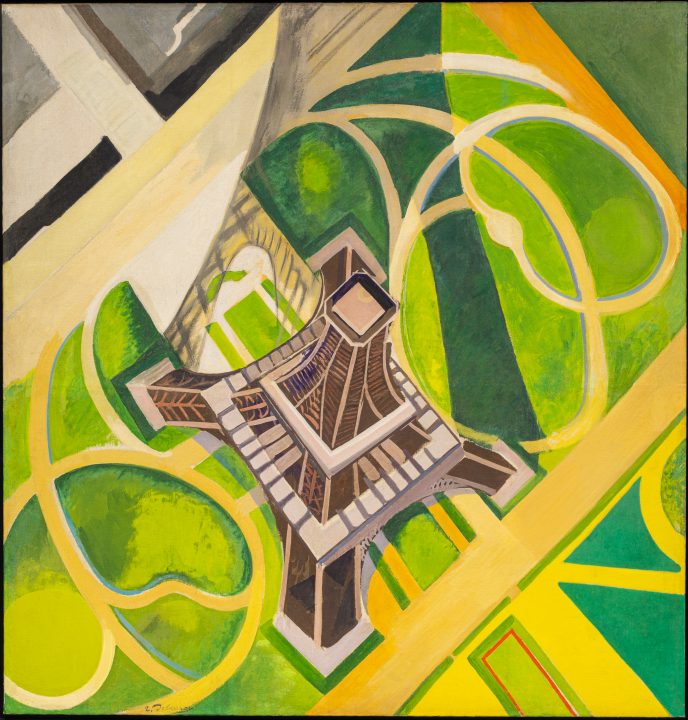
Robert Delaunay, Eiffel Tower and Gardens, Champ de Mars, (La Tour Eiffel et Jardin du Champ de Mars) 1922. Courtesy of Smithsonian’s Hirshhorn Museum and Sculpture Garden
By Sheila Wickouski
No two visits to “Revolutions: Art from the Hirshhorn Collection, 1860–1960” at the Hirshhorn Museum and Sculpture Garden will be the same.
This first of several exhibits celebrating the 50th birthday of the museum is impressive, consisting of over 200 artworks by over 100 artists, a broad scope still representing only a small fraction of the Hirshhorn’s collection of more than 13,000 works. The variety of styles and subjects unfolds in a presentation that is loosely grouped around art movements in the time frame of a century that was marked by major world events and changing ideas in science and technology.
While organized chronologically, the exhibit does not focus solely on one group of artists or a specific media or art movement, but flows through time, presenting opportunities to contrast and compare works across time boundaries.
At the entrance, to introduce the exhibit, shown side by side are “Modern Beginnings,” an examination of large-scale portraiture (a hallmark of social standing) of “Mrs. Kate A. Moore” (1884) by John Singer Sargent, a Hirshhorn gift, with Amoako Boafo’s “Cobalt Blue Dress” (2020), a recent acquisition.
Moving through the exhibition, all the art is not on the wall. Display cases of sculptural works provide an opportunity to reflect on artists’ work in a variety of media. Henri Matisse’s “Heads of Jeannette,” five sculptures made between 1910 and 1913, present a progression from representation to abstraction, indicating how rapidly 20th-century artists adopted abstract approaches.
“Abstraction and Construction” and “Vital Forms” are devoted to work by futurists, including four sculptures by Giacomo Balla, and to cubist works by artists Pablo Picasso, Fernand Léger and Yun Gee.
Modern warfare as well as rising nationalism are reflected in major works such as Marsden Hartley’s “Painting No. 47, Berlin” (1914–1915) and Childe Hassam’s “The Union Jack, New York, April Morning” (1918). Surrealism and Abstract Expressionism are well represented, but so too are other artworks, like the realist painting of George Wesley Bellows and Edward Hopper and lyrical landscapes by Georgia O’Keeffe and Horace Pippin.
What is delightful about the exhibit, and a feature which separates it from a walk through a “history of art”-style exhibit is the opportunities it presents to discover for yourself what is so alike and yet different in the placement of works nearby each other.
After a guided tour, I returned to view the exhibit on my own and spotted two of my favorite artists so positioned: Horrace Pippin’s “Holy Mountain III” (1945) and Daywood Bey’s photograph “UNTITLED #12 (THE MARSH) “ (2017). Pippin’s is bright colored while Bey’s photograph is so dark black until you must come very close to see the outlines of the reeds in the marsh at night.
As an art historian has said, you don’t have to own art works personally if you enjoy and appreciate art to consider it yours. Certainly the vastness and variety of art holdings in the Hirshhorn provide this experience, and a chance to celebrate with the Hirshhorn as they mark 50 years with this collection-spanning exhibition.
The exhibit is on view through April 20, 2025. Future exhibits will display works from the collection from 1960 to the present. Events for the year of celebration will be posted on the Hirshhorn web site, https://hirshhorn.si.edu/events/.

